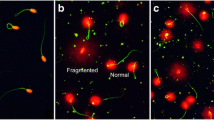Summary
-
1.
Two rabbit bucks were used for artificial insemination of thirty-five does. Genetic marks were arranged to track the paternity of each of the 584 offspring. Dilution of semen and volume of inseminate were standardized. About half the inseminations were homospermic, with semen from one sire in each inseminate; for heterospermic inseminations, semen of the two sires was mixed in. various proportions. The sires differed in weight, stock, genotype, inbreeding coefficient, mean ejaculate volume, and in some characteristics of their breeding performance.
-
2.
The results of homospermic and heterospermic inseminations were compared for gestation period, birth-rate, number of offspring per litter, weight of litter, weight and viabihty of offspring from birth to maturity, sex ratio and fertility of offspring. After heterospermic insemination, the figures obtained were intermediate between or of the same order as those obtained after the two kinds of homospermic insemination. No trace of ‘heterospermic vigour’ could be demonstrated for any item. Comparison of birth weight was a direct object of the experiment.
-
3.
After heterospermic insemination, one sire gave nearly three times as many offspring as the other, as calculated to equal volumes of semen. The difference is thought to reflect an inequality in the relative numbers of fertile spermatozoa in the semen of the two sires. Heterospermic insemination may afford a useful means of assessing this relative number in semen samples.
-
4.
After heterospermic insemination, the difference in birth weight between the two kinds of young appeared to be accentuated (enhancement effect), and there were associated changes in the mortality rate. The enhancement effect appeared evident up to 3 months of age.
-
5.
Mixed litters, containing both types of young, are found to have a high number of young per litter, with a low birth weight. These characteristics of the mixed litter are, however, probably due to studying mixed litters in isolation as an arbitrarily grouped class of data.
-
6.
In mixed litters the difference in mean birth weight of young from the two sires was not demonstrably dependent on some important variables; for example, season, maternal characteristics, weight of litter, number of young. Mixed litters may permit efficient comparison of the birth weight of offspring from two or more sires. With data from twenty-five mixed litters, an estimated 10.2 % difference in birth weight between the two kinds of young was significant at the 98–99% probability level.
-
7.
No qualitative exceptions to ordinary Mendelian inheritance were found in either the phenotype or genotype of offspring. Sex ratio was unaffected by heterospermic insemination. One doubtful alteration in a segregation ratio for skin colour was encountered.
-
8.
In general terms: a test experiment with heterospermic insemination in the rabbit failed to reflect the ‘heterospermic vigour’ claimed in Russian work, and no clear-cut non-Mendelian inheritance can be demonstrated; heterospermic insemination may afford an efficient means of progeny testing, and of assessing the relative numbers of fertde spermatozoa in semen samples; the data suggest an effect of heterospermic insemination on therelative weight and viability of two kinds of young, from birth to 3 mouths of age.
Similar content being viewed by others
References
Anderson, J. (1945).Tech. Commun. Bur. Anim. Br., Edinb., no. 6.
Armitage, P. (1955). Tests for linear trends in proportions and frequencies.Biometrics,11, 375.
[Beatty. R. A.] (1955).Research Report, 1952–1954,Inst. Anim. Genetics, Edinb., p. 25.
Beatty, R. A. (1956). Relation between genetic constitution of an offspring and weight of its littermates.Nature, Lond.,178, 48.
Bishop, M. W. H., Campbell, R. C., Hascock, J. L. &Walton, A. (1954).J. Agric. Sci.44, 227.
Edwards, R. G. (1955). Selective fertilization following the use of sperm mixtures in the mouse.Nature, Lond.,175, 215.
Fisher, R. A. (1930).Statistical Methods for Research Workers. Edinburgh and London: Oliver and Boyd.
Fisher, R. A. &Yates, F. (1948).Statistical Tables. Edinburgh and London: Oliver and Boyd.
Kopeć, S. (1923). On the offspring of rabbit-does mated with two sires simultaneously.J. Genet.13, 371.
Kushner, K. F. (1954). (The effect of heterospermic insemination in animals and its biological nature.)Izvestia Alcad. Nauk. SSSR, Ser. Biol., no. 1, p. 32 (as read in unpublished translation by D. Michie and A. McLaren).
Lopyrin, A. I. &Loginova, N. V. (1955). (The theory and practice of inseminating females with mixed semen).Usp. Sovr. Biol.39, 212 (as noted inAnim. Breed. Abstr. 1955, no. 1241).
Roberts, E. &Carroll, W. E. (1939). A study of hybrid vigour in a cross between Poland China and Duroc Jersey swine.J. Agric. Sci.59, 847.
Snedecor, G. W. (1943).Statistical Methods. Iowa State College Press.
Venge, O. (1950). Studies of the maternal influence on the birth weight in rabbits.Acta zool. Stockh.,31, 1.
Walton, A. (1945). Notes on the Technique of Artificial Insemination. London: The Holborn Surgical Instrument Co. Ltd.
Author information
Authors and Affiliations
Rights and permissions
About this article
Cite this article
Beatty, R.A. A pilot experiment with heterospermic insemination in the rabbit. J Genet 55, 325–347 (1957). https://doi.org/10.1007/BF02981647
Received:
Issue Date:
DOI: https://doi.org/10.1007/BF02981647




